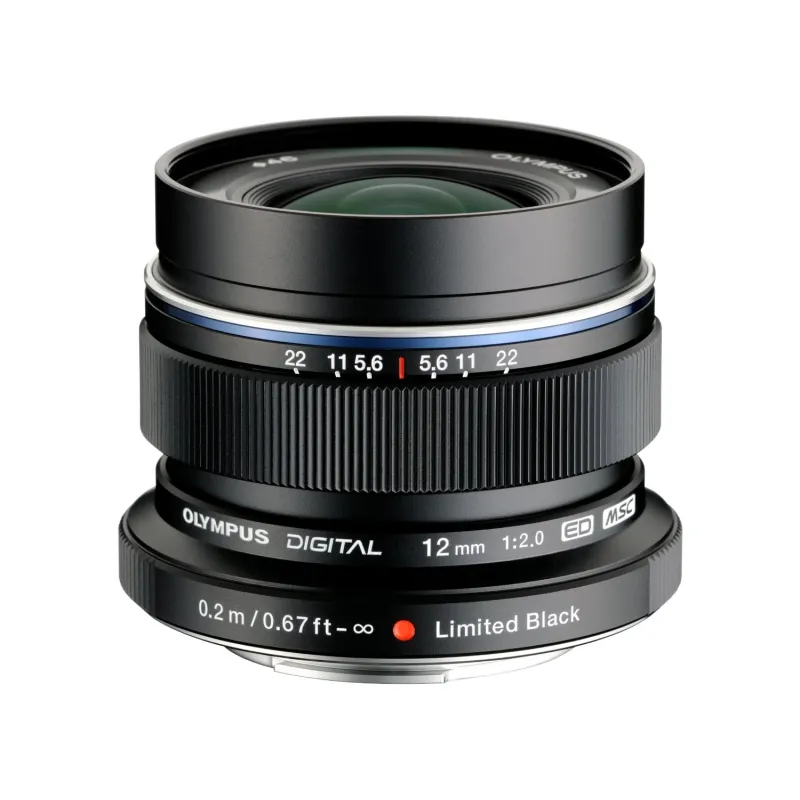
- Augstas kvalitātes 12 mm platleņķa objektīvs
- Ātra f/2,0 maksimālā apertūra
- Augstas kvalitātes Olympus optika
- M.Zuiko Premium sērijas augsta veiktspēja
- Saderīgs ar Mikro četru trešdaļu sistēmas bezspoguļa kamerām


vai pajautājiet par
| Bajonete | micro 4/3 (MFT) |
| Lens Format Coverage | Four Thirds |
| Lens Design | fiksēts |
| Objektīva fokusa attālums, mm | 12 |
| Focus Type | Autofocus |
| Image Stabilization | Ir |
| Objektīva tips | platleņķa |
| Filtra izmērs | 46mm |
| Maksimālā apertūra | f/2 |
- Special edition black model complete with matching metal lens hood and cap
- High-speed AF with MSC technology
- High-specification design with metal housing
- Versatile wide-angle fixed focal lens
- Snapshot focus mechanism
Product Description
The limited edition M.ZUIKO DIGITAL ED 12mm 1:2.0: First PEN compatible prime lens gives stunning 24mm equivalent wide-angle performance.

Click here for a larger image
Setting a new benchmark for miniaturisation. Olympus' award winning M.ZUIKO DIGITAL ED series lenses have secured another first in the M.ZUIKO DIGITAL ED 12mm 1:2.0 prime lens for Micro Four Thirds system cameras. Feeling solid in the palm and beautifully made thanks to an all-metal casing, this long-awaited optic delivers not only a fast aperture to make the most of available light but also an ultra wide 24mm equivalent performance in 35mm film terms. It's compact too and will easily slot into any trouser or jacket pocket. This limited edition designer kit includes matching lens hood and cap - all in classic black.
Stealth, spontaneity… and superb low light snapshots
Along with the PEN cameras' compact dimensions, the bright aperture of the much anticipated Olympus M.ZUIKO DIGITAL ED 12mm 1:2.0 allows users to shoot photos or HD video inconspicuously and achieve their best ever results in low light (say shooting interiors, or a sunset), without flash (where prohibited, such as in museums and churches), or without a tripod (busy areas and tourist spots). PEN users further benefit from the lens being automatically supported by the cameras' built in image stabilisation.
The fast lens is the best choice for spontaneous snapping too, thanks to built-in depth of field and distance indicators that reveal the distance at which objects are in focus, allowing the user to make adjustments on the hoof without having to consult the camera's display. These 'Snapshot Focus' indicators come into play in Manual mode, which is activated simply by pulling back the focus ring. Pan focus shooting, in which the subject and background are both in focus, is also possible, with the camera's dial set to A or M mode, the aperture to f/8.0 and the focal distance to three metres.

Click here for a larger image
Classic design, contemporary beauty
The Olympus M.ZUIKO DIGITAL ED 12mm 1:2.0 doesn't just do the job all PEN photographers have been hoping for when it comes to taking pictures and recording video; it looks the part too.
The physically compact lens has a high grade metal exterior, sophisticated texture and a high quality construction from the first component to the last. It has a classic design, and you could even say it's destined to become a design classic. Weighing a mere 130 grams, it has a maximum diameter of 56 mm and an overall length of just 43 mm.
Crystal clear images with high contrast and superb sharpness are achievable thanks to the constant aperture setting of f/2.0 plus the lens construction of 11 elements in eight groups including two aspherical lenses and one ED (Extra low Dispersion) lens. This has an enormous effect on correcting chromatic aberration due to the unique well-balanced dispersion of red and blue light.

Click here for a larger image

Click here for a larger image
Faster and quieter Auto Focus (AF)
With the Olympus M.ZUIKO DIGITAL ED 12mm 1:2.0 prime lens, the movie and still compatible ('MSC') AF mechanism benefits from the internal focusing mechanism used for conventional interchangeable lenses being improved by incorporating a screw drive mechanism - a metal shaft finished with sub-micron precision - instead of gears which cause noise. High precision plastics also ensure a quick, smooth, silent and moreover accurate AF drive.
Reduced lens flare, enhanced lens coating
The Olympus M.ZUIKO DIGITAL ED 12mm 1:2.0 isn't just the ideal lens to fit for low light shooting as well as being very convenient to carry; it's truly multipurpose, coming up trumps in bright(er) conditions too.
This is thanks to an enhanced multi-layer 'ZERO' lens coating - or ZUIKO Extra low Reflection Optical coating - that halves the would-be effects of ghosting and flaring when compared to conventional coatings, therefore drastically reducing the chances of them negatively affecting image quality. The thin yet solid film coating adopted is based on the multilayer technology utilised in microscopes.

Click here for a larger image
World's first mass production Dual Super Aspherical (DSA) lens
The M.ZUIKO DIGITAL ED 12mm 1:2.0 of course benefits from Olympus' rich heritage, high-end ZUIKO DIGITAL technologies and unparalleled know-how accumulated across many years in pursuit of high resolution and high performance.
It's the realisation of the world's first Dual Super Aspherical (DSA) lens - comprised of glass mould lenses with dual aspherical surfaces - on a mass production scale, with extremely large thickness differences between the centre of the lens and its peripheral areas. It's a highly refractive lens too, correcting a high percentage of spherical aberrations. By utilising an aspherical lens, aberrations that can't be corrected by spherical lenses are effectively compensated for.
In the production process, heating and slow cooling of moulds and glass are precisely controlled within a range of +/- 1° at around 500-600 degrees via special moulding machinery to avid cracking. Lens surface accuracy is precisely measured and evaluated using Olympus exclusive equipment possessing the world's best accuracy. In fact the accuracy of the mould requires double that of the lens itself. No wonder the process is known as 'Superb Moulding Technique.'
Box Contains
Olympus M.ZUIKO DIGITAL ED 12mm 1:2.0 Black
Metal Lens Cap Black
Metal Lens Hood Black
Warranty Card
Operating Instructions
| Bajonete | micro 4/3 (MFT) |
| Lens Format Coverage | Four Thirds |
| Lens Design | fiksēts |
| Objektīva fokusa attālums, mm | 12 |
| Focus Type | Autofocus |
| Image Stabilization | Ir |
| Objektīva tips | platleņķa |
| Filtra izmērs | 46mm |
| Maksimālā apertūra | f/2 |
- 1. Izvērtē savas iespējas.
- 2a. Ja vēlies iegādāties tikai vienu preci ar Aizdevums.lv līzingu, tad aizpildi pieteikumu šeit
- 2b. Ja vēlies iegādāties vairākas preces vai izmantot citu līzinga kompāniju, tad liec preces grozā, un pie pasūtījuma nodormēšanas izvēlies līzinga pakalpojumu.
Piedāvājam līzingu no Aizdevums SIA, Incredit SIA, ESTO.
Konsultanti pārbaudīs grozā esošo preču pieejamību un nosūtīs aizdevuma pieteikuma saiti. - 3. Ja saņemta pozitīva atbilde, sazinies ar mums par preces iegādi. Konsultanti pārbaudīs preces pieejamību.
- 4. Ja prece ir pieejama veikalā vai pasūtāma no noliktavas, un esi saņēmis apstiprinošu atbildi no mūsu konsultantiem, dodies pie mums uz veikalu, lai noformētu pirkuma un līzinga dokumentus.
- 4a. Vari arī lūgt mums izrakstīt rēķinu par šo preci un pats doties uz kādu no līzinga devēja filiālēm, lai noformētu līzinga dokumentus*.
- 5. Kad līzinga dokumenti ir noformēti, vari doties saņemt preci veikalā (ja tā ir uz vietas) vai informēt mūsu konsultantus, lai tā tiktu pasūtīta no noliktavas.
- *Līzingā iegādātām precēm ir iespējams noformēt piegādi, tāpēc visu iegādes procesu vari veikt arī attālināti.
**Tāda pati līzinga noformēšanas soļu secība ir arī InCredit Group piedāvātajiem līzingiem.
***Neskaidrību gadījumā sazinieties ar mūsu konsultantiem!
NB! Izmantojot līzinga pakalpojumus, rūpīgi izvērtējiet savas iespējas aizdevumu atmaksāt!
 Google
Google










